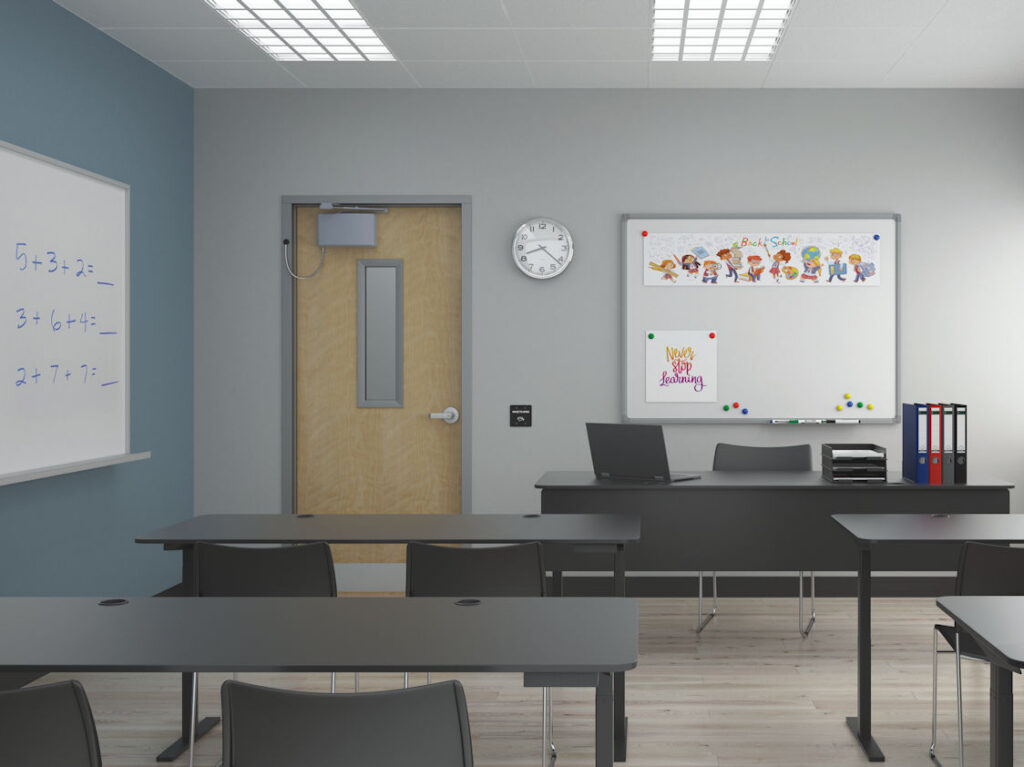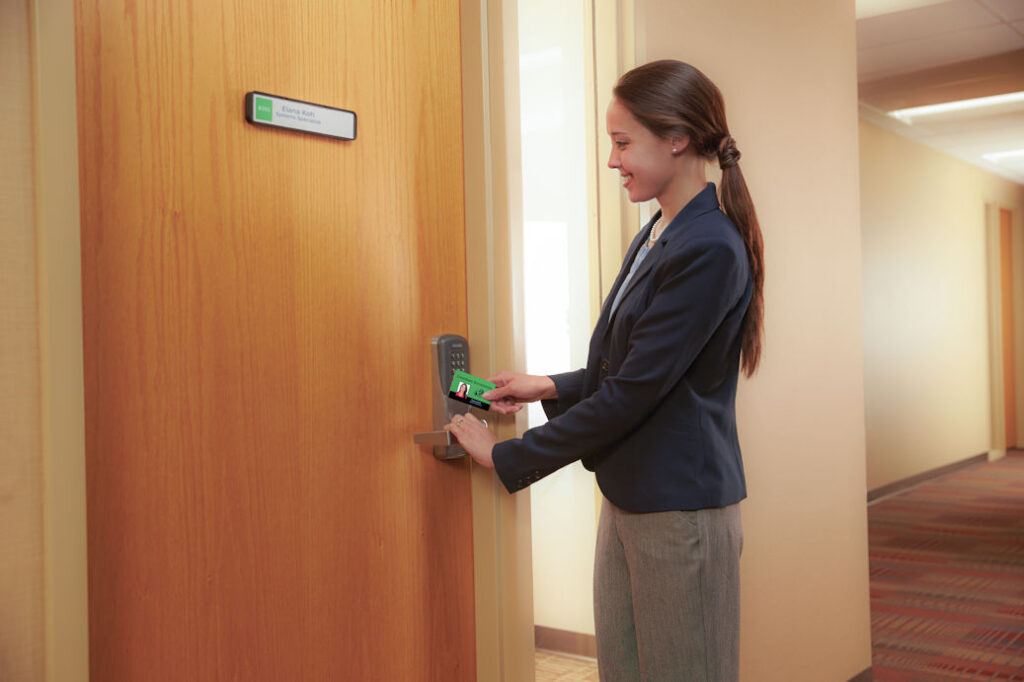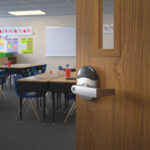This post was published in Doors & Hardware

Author’s Note: At the 2023 DHI conNextions Conference in Boston, I taught an interactive code update class in a game show format for an enthusiastic and competitive group of attendees. I am sharing some of the information from that session in this article, so everyone can benefit from what was covered in the presentation.
 When learning about the code requirements related to swinging door openings, there are several basic concepts to understand first:
When learning about the code requirements related to swinging door openings, there are several basic concepts to understand first:
- Adopted Codes – The model codes are updated every 3 years, but these codes may not be adopted in a particular jurisdiction right away. Most states and cities make local modifications to the model codes, so it’s important to check the adopted codes in a project’s jurisdiction for specific requirements. The updates presented here are changes to the model codes and may not apply in all locations.
- Changes vs. Clarifications – When a code or standard is modified, changes do not technically apply until they are adopted in the project’s jurisdiction. However, some code changes are actually clarifications that help to establish the intent of the codes. Learning about new requirements proactively can be very helpful when interpreting the codes.
- Use Groups – The use group or occupancy classification for a particular building (or portion of a building) will affect the code requirements for the space. For example, the egress requirements for an assembly occupancy such as a theater, will differ from those of a residential occupancy like a multifamily apartment building.
- Layered Requirements – Each door opening may be subject to one or more sets of code requirements. If a door is required for egress or provided for egress purposes, it must comply with the egress mandates of the adopted codes. Some openings will also be fire door assemblies, with prescriptive criteria that must be met. Most doors must also comply with the accessibility standards.
What’s new?
The 2024 editions of the International Building Code (IBC), the International Fire Code (IFC), and NFPA 101 – Life Safety Code are now complete, and the following topics are just a few of the most important changes that have been made with regard to swinging doors in recent editions of the model codes.
Classroom Security
After the 2018 code change cycle was complete, a Tentative Interim Amendment (TIA 1436) to NFPA 101 was approved, which modified the number of releasing motions allowed to unlatch an existing classroom door for egress. While the IBC and IFC continue to require one motion to unlatch all latching and locking devices simultaneously, NFPA 101 allows a second, non-simultaneous releasing motion for existing classroom doors in existing schools. The intent was to allow a separate deadbolt to be installed along with the latching hardware.

Existing classroom doors in existing schools are allowed by NFPA 101 to have two releasing motions for egress, but the I-Codes continue to require one releasing motion to unlatch all locks and latches simultaneously.
This change has been carried forward into the 2021 and 2024 editions of the Life Safety Code, but it’s important to remember that the second motion is only allowed in jurisdictions where NFPA 101 is the adopted code and the IBC and IFC do not apply. Some states and local jurisdictions have made code modifications that may also allow a second releasing motion. In addition to the unlatching requirements, the hardware must comply with the other mandates of the applicable codes and standards related to mounting height of the releasing mechanism, egress without the use of a key, tool, special knowledge or effort, and operation without tight grasping, pinching, or twisting of the wrist. Beginning with the 2018 model codes, classroom doors must also allow an authorized person to enter from the outside with a key, credential, or other approved means.
Operable Force for Door Hardware
In the 2010 edition of the ADA Standards for Accessible Design, an editorial change was made which affected the allowable operable force for door hardware. These standards require hardware to operate with 5 pounds of force, maximum. Prior to this change, operable force for hardware was not addressed in the accessibility standards.
The 2017 edition of ICC A117.1 – Accessible and Usable Buildings and Facilities includes a limitation on operable force that differs from the 5-pound limit in the ADA standards. A117.1 states that the operational force for door hardware is limited to 15 pounds of pushing or pulling motion (ex. panic hardware), and 28 inch-pounds of rotational motion (ex. lever handle). The same requirements were included in the 2021 edition of the IBC and IFC, which creates a conflict with the 5-pound limit in the ADA standards. This conflict will exist until the ADA standards are updated, so it’s important to consider how to manage this inconsistency on current and upcoming projects.
Automatic Door Operators
Automatic operators are sometimes installed to resolve accessibility issues related to manually operated doors. For example, if a door opening does not have the maneuvering clearance that is required by the accessibility standards for a manual door, adding an auto operator may bring the door into compliance, as the automatic door section of the standards does not require the same clearance.
In the past, automatic doors were not specifically required by the model codes or the accessibility standards, but a change to the 2021 IBC mandates auto operators in certain locations. In buildings of particular use groups and occupant loads, at least one automatic door or set of automatic doors (exterior and vestibule) must be provided at each accessible public entrance. This applies to assembly occupancies (with the exception of Use Group A-5) that have a calculated occupant load of more than 300 people, and to business, mercantile, and residential Group R-1 occupancies with a load of more than 500 people.

When the path of egress serving an exterior space passes through the interior of the building, the 2021 I-Codes include new requirements for the egress doors.
Doors Serving Roofs and Other Exterior Spaces
The model codes have been clarified over the last few editions regarding security for doors serving roofs that are not intended to be occupied, such as roofs that contain mechanical equipment. Generally, the IBC and IFC allow doors serving unoccupied roofs to be locked, preventing access from the stairwell to the roof and from the roof to the stairwell. NFPA 101 allows the door to be locked on the roof side if it is also locked on the stair side.
The 2021 IBC and IFC include additional requirements that apply to exterior spaces where the egress route passes through the building, for example, a roof top restaurant or an enclosed courtyard. The need for egress from these spaces often creates a security problem by allowing unauthorized people to access the exterior space and enter the building. Prior to the 2021 editions, the codes did not include prescriptive information for securing these doors.
The I-Codes now allow the doors serving these exterior areas to be locked when the space is not occupied, if certain criteria are met. The maximum occupant load of the space must not be more than 300 people, and signage must be posted stating that the door is to remain unlocked when the outdoor area is occupied. The locking device must be key-operated and readily distinguishable as locked – such as a double-cylinder deadbolt with an indicator. Each exit access door serving the exterior space must have a clear vision panel that measures at least 5 square feet, and at least one of these openings must have a weatherproof telephone or two-way communication system mounted nearby on the exterior side. The codes include additional detailed requirements for the communication system.
Electrified Hardware
For more than 20 years, the Builders Hardware Manufacturers Association (BHMA) has been working in code development, including many proposals related to electrified hardware. Several important changes have been made to the 2024 model codes:
- Elevator Lobby Egress Doors – In many buildings, the elevator lobby does not have direct access to a stairwell/exit; building occupants must leave the elevator lobby to access a means of egress. This can create a security issue by allowing unauthorized access to tenant spaces. Beginning with the 2009 edition of NFPA 101, the code has included a section specific to locking these doors electrically, but the I-Codes did not include a comparable set of requirements. The 2024 IBC and IFC will include a section similar to the requirements of NFPA 101, which allows elevator lobby doors to be locked with fail safe electrified locks if the other criteria in the code are met. This includes a two-way communication system in the elevator lobby and hardware that unlocks immediately upon activation of the fire alarm or sprinkler system, along with other mandates. Refer to the adopted code(s) for detailed information.
- Stairwell Reentry – Although the industry typically specifies and supplies fail safe locking devices on stairwell doors to allow building occupants to leave the stairwell during a fire, the codes did not mandate a specific hardware type. The 2024 I-Codes will clarify that the locking hardware must unlock on the stair side via a signal from the fire command center or a location inside the building’s main entrance, upon activation of the fire alarm signal, and/or power failure to the electrified lock. The power failure requirement means that a fail safe lock must be used.
- Electromagnetic Locks – Currently, the model codes allow electromagnetic locks to be released for egress in one of two ways:
- Option A is for the lock to be released by the activation of a sensor detecting a building occupant approaching the door on the egress side. This type of system also requires the lock to be released by an auxiliary push button beside the door, by activation of the fire alarm or sprinkler system (if present), and upon power failure.
- Option B is for the lock to be released by a switch in the door-mounted hardware (ex. RX switch in panic hardware, lever handle, or sensor bar). With this type of system, the lock must also release for egress upon power failure, but the auxiliary switch and fire alarm release mentioned in Option A are not required by the model codes for Option B.
- A change proposed by a code official and approved by the technical committee states that if the door is required to have panic hardware and is also equipped with an electromagnetic lock, Option B must be used. Option A – the mag-lock released by a sensor – will no longer be allowed on doors with panic hardware. The panic hardware will have to incorporate a switch the releases the mag-lock as described in Option B above.
- Listings for Electrified Hardware – The model codes currently require some electrified hardware to be listed to UL 294 – Standard for Safety for Access Control System Units. This requirement typically applies when the hardware is part of a special locking arrangement. Beginning with the 2024 model codes, this hardware may be listed to either UL 294, or UL 1034 – Standard for Safety for Burglary-Resistant Electric Locking Mechanisms.

A revision to the 2024 I-Codes clarifies that a door with access control hardware is not considered a special locking arrangement if it is readily openable from the egress side without a key or special knowledge or effort.
The 2024 I-Codes include another very important clarification related to electrified hardware. One of the issues that causes the most confusion with the codes related to door openings is the concept of special locking arrangements vs. normal locking arrangements. The electrified hardware used in the various types of special locking arrangements is addressed in specific code sections that ensure a balance of security and life safety.
However, the most common electrified hardware applications are not special locking arrangements – they are normal locking arrangements. This hardware allows free egress the same way standard mechanical hardware does and complies with the codes that address standard locking or latching hardware. Because this was not completely clear in the model codes, code officials and others would often try to apply one of the special locking arrangements sections to a door with a normal locking arrangement, just because the hardware was electrified. There was no specific section in the codes that applied to electrified hardware that allowed free egress.
This will change in the 2024 I-Codes, with a clarification stating that electrified hardware used in an access control system must either comply with one of the sections addressing special locking arrangements, OR it shall be readily openable from the egress side without the use of a key or special knowledge or effort. Stated another way, access control hardware that is readily openable from the egress side is not required to comply with the sections on special locking arrangements.
Here is the revised IBC section for reference:
Monitored or recorded egress, and access control systems. Where electrical systems that monitor or record egress activity are incorporated, or where the door has an access control system, the locking system on the egress side of the door shall comply with Section 1010.2.11, 1010.2.12, 1010.2.13, 1010.2.14 or 1010.2.15 or shall be readily openable from the egress side without the use of a key or special knowledge or effort.
For more information about the life safety, fire protection, and accessibility requirements that apply to door openings, refer to the codes and standards that have been adopted in the project’s jurisdiction. The Authority Having Jurisdiction (AHJ) will make the final determination on matters of code compliance.
You need to login or register to bookmark/favorite this content.









Great update! Thanks Lori.